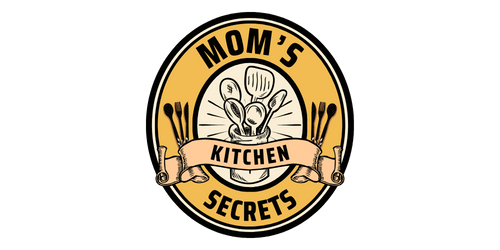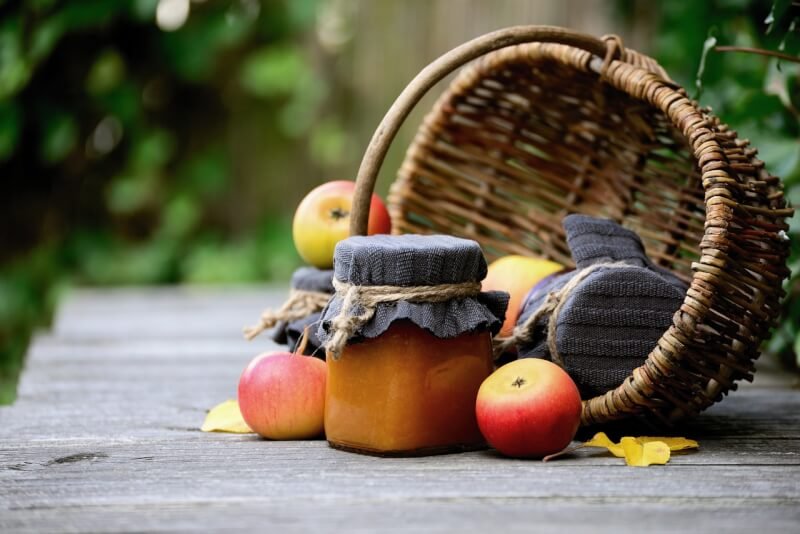Are you tired of wasting fruits and vegetables that go bad before you have a chance to eat them? Look no further! In this article, you will discover a variety of practical and easy ways to preserve your favorite fruits and vegetables, ensuring that they stay fresh for longer periods of time. Whether you prefer canning, freezing, drying, or pickling, we have got you covered with expert tips and techniques that will help you enjoy the natural goodness of fruits and vegetables all year round. Say goodbye to food waste and hello to delicious and nutritious preserved produce!
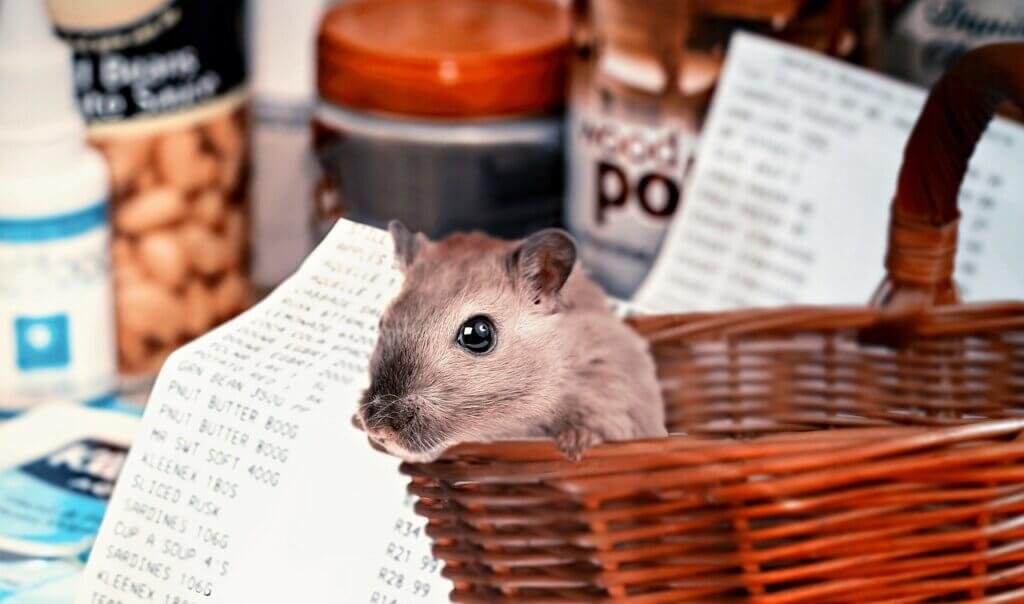
1. Canning
Canning is an excellent way to preserve fruits and vegetables, ensuring that you can enjoy them long after their peak season. There are two popular methods of canning: pressure canning and water bath canning.
Pressure Canning
Pressure canning is a method that uses high heat and pressure to kill bacteria and other microorganisms, ensuring the safety of your preserved goods. This method is suitable for low-acid foods like vegetables, meat, and poultry. To pressure can, you will need a pressure canner, which is specifically designed to reach and maintain the high temperatures necessary for safely preserving low-acid foods.
Water Bath Canning
Water bath canning, also known as boiling water canning, relies on the natural acidity of certain foods to create an inhospitable environment for bacteria. This method is primarily used for high-acid foods like fruits, pickles, and tomato-based products. To water bath can, you will need a large pot, a rack to elevate the jars, and canning jars with appropriate lids.
Pickling
Pickling is a fantastic preservation technique that involves immersing fruits or vegetables in a brine or vinegar solution. The acidic environment of the pickling solution inhibits the growth of bacteria and allows you to enjoy tangy and flavorful preserved delights. Pickled fruits and vegetables can be enjoyed on their own or as a delicious addition to sandwiches, salads, and more.
2. Freezing
Freezing is a convenient and simple method of preserving fruits and vegetables while retaining their nutritional value and flavor. Let’s explore how to properly prepare fruits and vegetables for freezing, the blanching process, and the best packaging methods to ensure longevity.
Preparing Fruits and Vegetables for Freezing
Before freezing, it is crucial to prepare fruits and vegetables properly. Start by washing them thoroughly and removing any stems, seeds, or peels. It’s important to remember that not all fruits and vegetables freeze well, so do some research or consult a reliable resource to ensure you’re freezing the right ones. Some items may require blanching before freezing to maintain their quality.
Blanching
Blanching is a simple process that involves briefly immersing fruits or vegetables in boiling water, followed by rapid cooling in ice water. This helps preserve the color, flavor, and texture of the produce. Blanching is particularly beneficial for vegetables and is recommended before freezing items like broccoli, green beans, and carrots. Be sure to follow specific blanching times for different fruits and vegetables to achieve optimal results.
Packaging for Freezing
Proper packaging is vital to maintaining the quality of your frozen fruits and vegetables. Place the blanched and cooled produce in airtight containers or plastic freezer bags, removing as much air as possible to prevent freezer burn. Label the containers or bags with the contents and the date, as this will help you keep track of their freshness. It’s also a good idea to portion your frozen goods into smaller containers or bags for easier use and less waste.

3. Drying
Drying is an ancient preservation method that removes moisture from fruits and vegetables, preventing the growth of microorganisms. Here are three effective ways to dry your produce: sun drying, oven drying, and using a food dehydrator.
Sun Drying
Sun drying is a traditional and natural method of drying fruits and vegetables. To sun dry, spread the produce out on a clean tray or screen and place it in a sunny spot, ensuring proper airflow. It’s essential to protect the food from pests and dust by using mesh screens or covers. Depending on the weather conditions, sun drying can take several days to a week. This method works best in hot, dry climates.
Oven Drying
If you don’t have access to ample sunlight or live in a humid climate, oven drying is a convenient alternative. To oven dry, arrange sliced fruits or vegetables on a baking sheet and place them in an oven set to a low temperature (around 140°F or 60°C). Leave the oven door slightly ajar to allow moisture to escape. It’s crucial to periodically check on the produce and rotate the trays for even drying. Oven drying typically takes several hours to a day, depending on the thickness of the food.
Food Dehydrator
A food dehydrator is an efficient appliance designed specifically for drying fruits, vegetables, and other foods. It offers precise temperature and airflow control, ensuring consistent results. To use a food dehydrator, follow the manufacturer’s instructions for arranging the produce on the trays and setting the temperature and drying time. Food dehydrators provide a convenient and reliable way to preserve your favorite fruits and vegetables without the need for abundant sunlight or constant monitoring.
4. Fermenting
Fermenting is a fascinating preservation method that not only extends the shelf life of fruits and vegetables but also introduces a unique and tangy flavor profile. There are several fermentation techniques to explore, including lactic acid fermentation, salt fermentation, and brine fermentation.
Lactic Acid Fermentation
Lactic acid fermentation is the process of preserving food using beneficial bacteria that convert sugars into lactic acid. This method is commonly used to ferment vegetables, such as cabbage for sauerkraut or cucumbers for pickles. The key to successful lactic acid fermentation is creating an anaerobic (oxygen-free) environment to promote the growth of beneficial bacteria while preventing the growth of harmful bacteria.
Salt Fermentation
Salt fermentation, also known as dry salting, involves coating fruits or vegetables in a layer of salt to draw out moisture and create an inhospitable environment for bacteria. The salt acts as a preservative and provides a unique flavor. Salt fermentation is commonly used for preserving items like lemons, olives, and various vegetables. It’s important to follow specific recipes and guidelines to ensure the correct salt-to-produce ratio and fermentation time.
Brine Fermentation
Brine fermentation is a technique that involves submerging fruits or vegetables in a saltwater solution. The saltwater brine ferments the produce, creating a deliciously tangy and preserved end product. Brine fermentation is commonly used for pickles, kimchi, and other fermented vegetables. It’s essential to use the correct ratio of salt to water and maintain proper temperature and hygiene throughout the fermentation process.
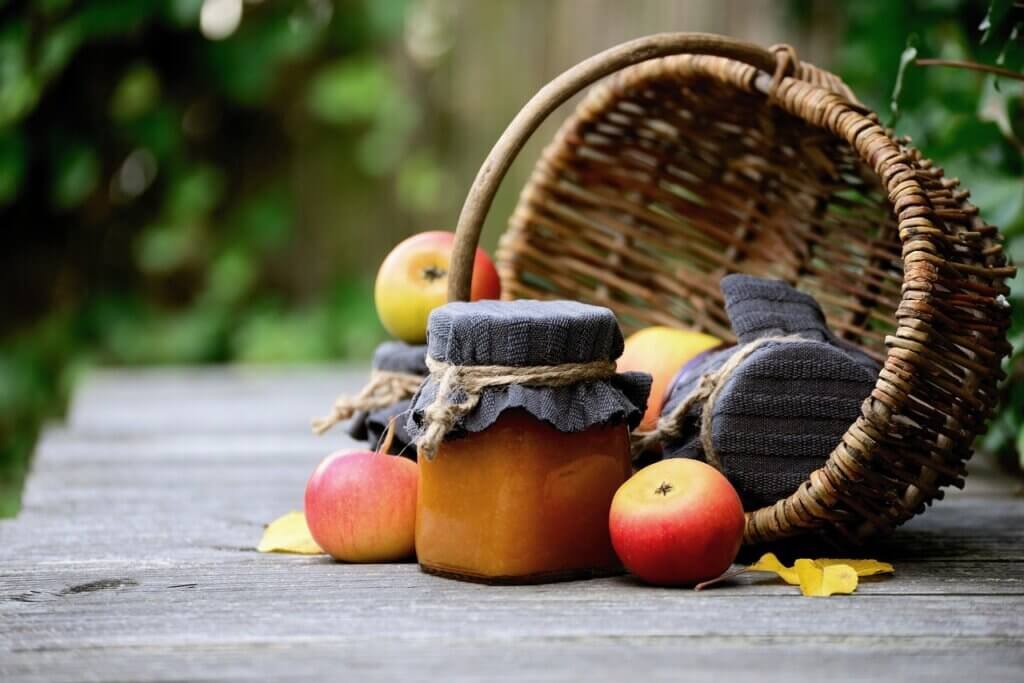
5. Making Jams and Preserves
Making jams and preserves is a delightful way to preserve the flavors of your favorite fruits and enjoy them throughout the year. Let’s explore the process of cooking and preserving fruits, making fruit jams, and creating fruit preserves.
Cooking and Preserving Fruits
To make jams and preserves, you will first need to cook the fruits to release their natural flavors and break down the cell walls. This process softens the fruits and allows them to thicken when combined with sugar and pectin. The cooked fruits are then preserved in jars, ensuring their long-term storage and enjoyment. Remember to select ripe and high-quality fruits for the best results.
Making Fruit Jams
Fruit jams are made by cooking crushed or chopped fruits with sugar and pectin, a natural thickening agent derived from fruits. The mixture is simmered until it reaches the desired consistency, then transferred into sterilized jars. Fruit jams are delicious on toast, stirred into yogurt, or used as a filling for cakes and pastries. Experiment with different fruits and flavor combinations to create your signature jams.
Making Fruit Preserves
Fruit preserves differ from jams in that they contain larger chunks of fruit and have a softer texture. The process of making fruit preserves is similar to making jams, but the fruits are cooked for a shorter duration to maintain their shape and texture. Preserves are delightful alongside cheeses, on scones, or as a topping for ice cream. Don’t forget to label and date your jars so that you can savor your homemade preserves long after you’ve made them.
6. Salting
Salting is a preservation technique that draws moisture out of fruits and vegetables, creating an environment that is hostile to bacteria and other microorganisms. While commonly associated with meat and fish, salting is also an effective method for preserving some fruits and vegetables.
Vegetable Salting
Vegetable salting involves coating or immersing vegetables in salt or brine to remove moisture and prevent spoilage. This method is particularly useful for preserving crunchy vegetables like cabbage, radishes, and cucumbers. Salted vegetables can be enjoyed on their own or incorporated into various dishes for added flavor and texture.
Fruit Salting
Salting fruits is less common than salting vegetables but can be a unique preservation technique for certain varieties. Fruits like lemons, limes, and watermelon rinds can benefit from salting, as it enhances their flavors and extends their shelf life. Salted fruits can be used as condiments, additions to cocktails, or in creative culinary preparations.
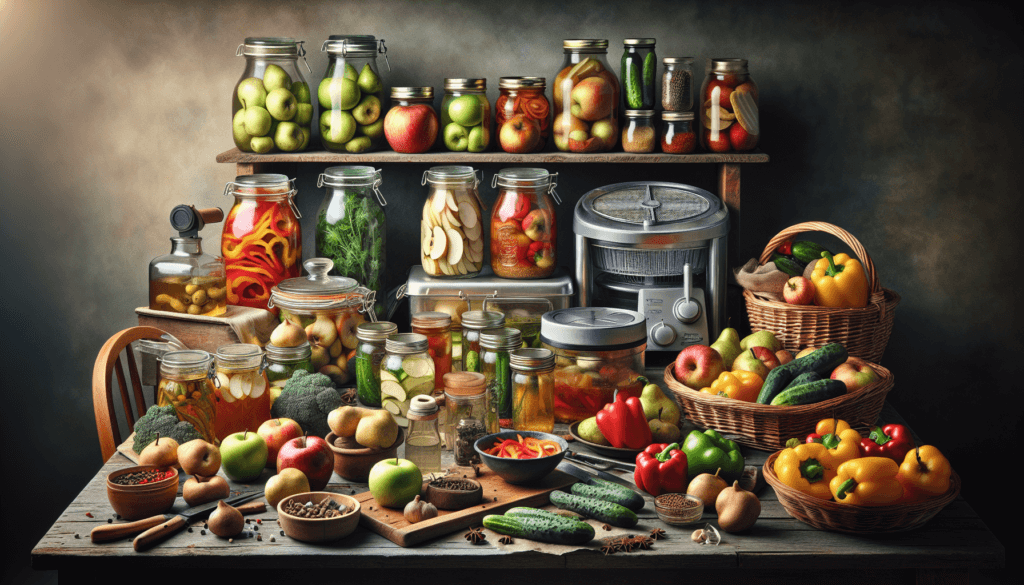
7. Pickling
Pickling is a versatile preservation method that can be applied to a wide range of fruits and vegetables. The pickling process involves submerging the produce in a solution typically made from vinegar, water, salt, and spices. Let’s explore both vegetable and fruit pickling methods.
Vegetable Pickling
Vegetable pickling is a popular preservation method that yields crisp, tangy, and flavorful preserved vegetables. Commonly pickled vegetables include cucumbers, carrots, onions, and cauliflower, but you can get creative with your selection. To pickle vegetables, wash and cut them into desired shapes, then pack them tightly into sterilized jars. Pour the pickling solution over the vegetables and seal the jars. Allow the flavors to develop over time, and your pickled vegetables will be ready to enjoy.
Fruit Pickling
Pickling isn’t just limited to vegetables; certain fruits can also be transformed into delightful pickled treats. Fruits like peaches, plums, and cherries can be pickled to preserve their natural sweetness with a tangy twist. The pickling solution often includes vinegar, sugar, water, and various spices. Pickled fruits can be served alongside savory meats, added to salads, or enjoyed as a unique accompaniment to cheese boards.
8. Vacuum Sealing
Vacuum sealing is a fantastic method for preserving fruits and vegetables, as it removes air from the packaging, preventing the growth of mold and bacteria. Let’s explore how to prepare for vacuum sealing and the vacuum sealing process itself.
Preparing for Vacuum Sealing
Before vacuum sealing your fruits and vegetables, it’s essential to clean and prepare them properly. Wash and dry the produce thoroughly, removing any blemishes or damaged portions. Cut larger items into smaller pieces for easier sealing and storage. It’s also important to select appropriate vacuum-sealable bags or containers that are suitable for long-term storage in the freezer or pantry.
Vacuum Sealing Process
Once your fruits and vegetables are prepped, it’s time to seal them using a vacuum sealer machine. Place the produce in a bag or container designed for vacuum sealing, leaving enough room for the sealing process. Follow the manufacturer’s instructions to ensure a proper seal. Vacuum sealing removes the air from the packaging, creating an airtight environment that helps maintain the quality and freshness of your fruits and vegetables. Label the packages with the contents and date for future reference.
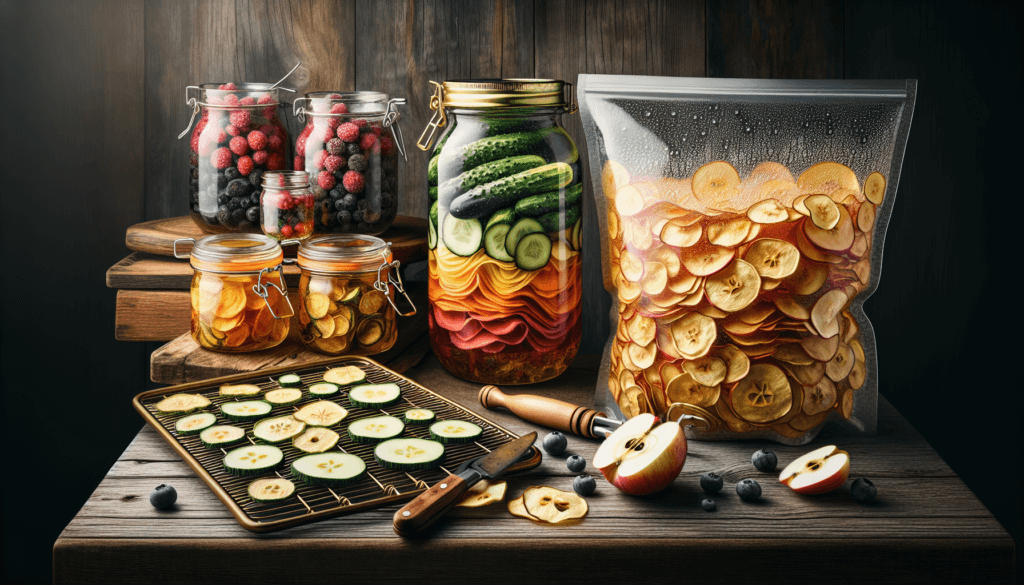
9. Using Sugar Syrups
Sugar syrups can be used to preserve both fruits and vegetables, enhancing their natural flavors while providing a sweet and syrupy treat. Here’s how to make syrup for preserving fruits and vegetables.
Syrup for Preserving Fruits
To make syrup for preserving fruits, combine sugar and water in a saucepan, using a ratio of sugar to water suitable for the desired sweetness. Bring the mixture to a boil and stir until the sugar dissolves completely. Remove the syrup from the heat and allow it to cool. Once cooled, pour the syrup over your prepared fruits in sterilized jars, ensuring the fruits are covered. Seal the jars and store them in a cool, dark place. The syrup not only helps preserve the fruits but also acts as a delectable topping for pancakes, waffles, and desserts.
Syrup for Preserving Vegetables
Sugar syrups can also be used to preserve certain vegetables, particularly when combined with vinegar and spices for a sweet and tangy flavor. To make syrup for preserving vegetables, follow the same process as for fruits but adjust the sugar-water ratio to taste. Consider adding spices like cloves, cinnamon, or peppercorns to infuse additional flavors into the syrup. Pour the prepared syrup over the vegetables in sterilized jars, ensuring they are completely covered. Seal the jars and store them in a cool, dark place, allowing the flavors to develop over time.
11. Storing in Oil
Storing fruits and vegetables in oil is an excellent preservation technique that not only prolongs their shelf life but also imparts a rich and flavorful dimension. Let’s explore how to select the right oil and the process of storing fruits and vegetables in oil.
Oil Selection
When storing fruits and vegetables in oil, it’s important to select an oil that resists rancidity and provides a neutral base for preserving the flavors. Extra virgin olive oil is a popular choice due to its stability and mild taste, but other oils like canola, sunflower, or avocado oil can also be used. Avoid oils with strong flavors or low smoke points, as they may overpower or spoil the preserved fruits and vegetables.
Storing Process
To store fruits and vegetables in oil, start by washing and thoroughly drying the produce to minimize moisture content. Cut or slice the fruits and vegetables into desired shapes and sizes. Arrange them in sterilized jars, leaving a bit of headspace. Pour the selected oil over the produce, ensuring that they are completely submerged. This helps create an oxygen-free environment that inhibits bacterial growth. Seal the jars tightly and store them in a cool, dark place. As the produce ages in the oil, it will continue to develop unique flavors and become even more delicious with time.
Preserving fruits and vegetables allows you to enjoy their flavors and nutrients throughout the year, even when they are out of season. Whether you choose canning, freezing, drying, fermenting, making jams or preserves, salting, pickling, vacuum sealing, using sugar syrups, or storing in oil, there are various methods available to suit your preferences and the produce you have on hand. Experiment with different preservation techniques and savor the fruits of your labor long after harvest season has passed. Happy preserving!
